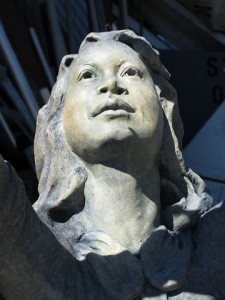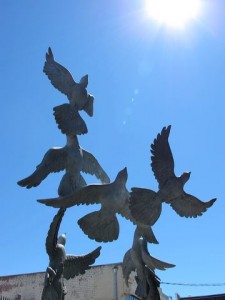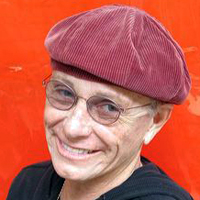“We lived in a bubble”
In 2011, I was driving up to Martha’s Vineyard to find out if perhaps I wanted to settle there. I stopped in Birmingham to see friends for a few days – Hank and Martha Black. Hank and I had been friends since the University of Alabama when he was a reporter. Coming home from work, he brought in a tiny advertisement from Weld for Birmingham, asking for sculptors to compete to create a memorial to the four girls who were in the bathroom when the Sixteenth Street Baptist Church was bombed by the Ku Klux Klan (KKK) in 1963. Excited, Hank asked me to read it and said that it was for me. Curious, I read it and agreed with him. Here in my hand was a piece that fit my philosophy of life and my small but constant battle for social justice wherever I happened to be. We noted that there were only four days left before the final due date. Usually it takes me and my web master a month or more to create a proposal for a particular competition. Instead, Martha helped me for four days and nights to run around getting details, photocopies, and leather-bound books for presentations. Usually I insert schematic drawings, elevations, site specific details, and of course, drawings of the potential piece, then load it all onto a flash drive or a CD.
Evelyn Allen, mother of our former Alabama First Lady Lori Allen Siegelman, my second Mom, let us spread out all our work on her living room floor in her home on top of Red Mountain, where we had a killer view of Jones Valley. So many people helped bring those bound proposals together. Southside UPS and the Birmingham Public Library’s Southside Branch helped often. They knew my name. I would come into the library and ask, “Where is the Spike Lee movie? I have to have the Spike Lee movie ‘4 Little Girls.’ I need it now, today. When is it coming back?” So, the librarians helped me with my research but I don’t think they really knew what I was doing. Kind. Martha and I drove the six bound proposals and a 3-foot by 2-foot presentation board with the glued-on design downtown to the appropriate address printed in the ad, with 20 minutes to spare. I think we double parked.
It was time to “come home,” because I had run from Birmingham, as soon as I could.
A Birmingham childhood
We were all brought up, those of us who took advantage of it, with huge independence. We had money and time, and we were given free rein. We would be gone all day on Saturday, just had to be home by nightfall. We’d ride our bikes to the Vulcan statue on the top of Red Mountain, the hill that separated us from downtown Birmingham.
Plenty about Birmingham life was really wonderful and good, and then of course there was the other side that was intolerant, small-minded, uneducated about the world. It just perpetuated a style of living and a xenophobic philosophy. There were very strict rules on behavior and dress.
We were probably one of the few families that listened to and enjoyed African American music or Calypso music – even though when we went for proms and parties like that, we had the Four Tops there! There was an abundance of money in Mountain Brook, so we got to hear many similar groups. But god forbid we should go up and talk with one of the performers.
We got glimpses of the other side of Birmingham. Our housekeeper, Mary Mack, used to throw us in the car to go grocery shopping near where she lived. Once she showed us her home. That was an eye opener. It was like an old railroad house, one long little home. You’d go up on the porch and through the front door, and there was the living room and then the kitchen and then the bedroom – that was it. I don’t even remember where the bathroom was. I don’t think Mama ever knew that we went there. Every one of Mary’s friends was kind to us.
Mary would take us to the movies in Homewood. That’s where we discovered immediately what segregation meant. We’d climb up to the balcony, through the door that said “Coloreds Only.” Of course we thought it was glorious. We could spy on everyone, we could see what everyone was doing.
When “To Kill a Mockingbird” came to Birmingham in 1963, I went to see it with my friend Phillip Alford. I knew Phillip from Town and Gown Theatre where we were thespians together, before he landed the role of Jem in that movie. I didn’t see it as being any really huge thing. He was a friend, and he was in a movie, and there he was, 12 feet, 15, 20 feet tall! Just he and I went–we held hands.
The Sunday that Sixteenth Street Baptist Church was bombed, I didn’t hear a word about it that day, not from my parents, not from anyone. When we got to school on Monday, there was kind of a whoosh. Just whisperings. You just sort of felt it, heard bits and pieces. It was “the talk” for the next week or so, and we were told not to go over the mountain from our protected Mountain Brook neighborhood into downtown Birmingham.
In Mountain Brook, with those imaginary lines of demarcation, there were certain areas and neighborhoods you didn’t cross. There was a lot we didn’t know. We lived in a bubble. We hadn’t heard about the Children’s Crusade that May. Until this past year, while researching the Four Spirits monument, I had never heard about Dynamite Hill. It was really an impenetrable bubble we lived in.
Born, bred, and fled Birmingham
Getting out of Birmingham was not easy. I could not breathe.
 I had left my senior semester of high school by getting a job offered by Cathy Crawford with Town and Gown Theatre to perform every night in a different city from St. Louis to Miami to off-Broadway in NYC, dancing and singing every night in the musical “The Boy Friend.”
I had left my senior semester of high school by getting a job offered by Cathy Crawford with Town and Gown Theatre to perform every night in a different city from St. Louis to Miami to off-Broadway in NYC, dancing and singing every night in the musical “The Boy Friend.”
It was difficult, strenuous, lifting costumes each day off the bus, running through a rehearsal, barely eating, and performing that evening, then sleeping at a rather poor motel, and up at 5 a.m. to go into the next town, schlepping all of your costumes and clothes. While on the road, my sweet mother called me asking if I was pregnant. Right. No one could have run ragged from day to day for three months and have a baby bump exposed on the stage, not to mention the sheer fatigue of the work. Gossip is started by bored trivial lives. The film “Doubt” hit straight home for me. I returned with $1,000 in my pocket, made up my semester in three weeks, and graduated with my class.
That was my ticket out of Birmingham. I reluctantly left for NYC, marrying a Latino University of Alabama student from Hell’s Kitchen, now gentrified. Raymond Gonzalez, my best friend and then my husband, later became Nina Simone’s manager while living in Paris.
The Four Spirits monument
Before I even knew if I had won the competition I started working on research. I had left a commission I was working on outside of Bangkok, Thailand, in Sai Noi at TMC Bronze Foundry for a group of fine women in Morro Bay, California. The sculpture, “For Those Who Wait,” memorializes many of their husbands, professional fishermen lost at sea. They generously let me stop work on their commission to come to Birmingham because of the historical importance and the time constraints. The unveiling date of September 15, 2013 (now Saturday the 14th at 4:00 p.m.), left only four months to create, end, and send. This sculpture would have normally taken 9 to 15 months.
I began by talking with people who knew Birmingham’s history. The Fine Arts Theatre was presenting a documentary on thespians from two schools from ethnically different parts of Birmingham on the making of their stage production “To Kill a Mockingbird.”
Hank told me Carolyn McKinstry, author of “While the World Watched” and president of the Board for the Four Spirits monument, would be there, along with Diane McWhorter, author of “Carry Me Home.” Maybe I could get a chance to speak with them, Hank said. I believe I called Mr. Chervis Isom, vice president and treasurer of the Four Spirits Board, and asked him to let Ms. McKinstry know I was not a “groupie” and was working on research, with the possibility of winning the competition. She shared the details of her story of barely escaping the church bombing and losing her best friend, Cynthia Wesley.
McWhorter proved too busy with immediate engagements but I caught up with her a few days later at the Alabama Book Store in Homewood when she came to Birmingham for a book signing. I asked how, while researching and writing her Pulitzer Prize-winning book, she had not become an alcoholic, drug addict, or just plain ole “Zeldafied”? She answered, “It took me 17 years and I took many breaks in between.” Oh damn. Trouble. I wanted Sage Information from a pro, but this news was obviously not going to be helpful during my four-month research-sculpting marathon – across the country, alone in Berkeley. If I had not had emails from McKinstry and Isom along with phone calls, at crucial moments of fever and doubts, from Isom and several other friends and family from around the world, I would have been in one of the three categories above, if not all three.
People talk about the girls being a sacrifice. These girls would not have volunteered to die that day. So I oppose the use of the word sacrifice, as it falsifies history. It is erroneous.
Actually they were not “little girls,” except Denise, who was 11. They were mature, in their menses, blooming breast buds, becoming young women. This misnomer was taken from Spike Lee’s Film, “4 Little Girls” and stayed. Do we think because they might have been mature it would not hold as much tragedy or injustice as if they had been little innocent girls? I do not care for history being wrong. We are lied to often, each lie backed by some sort of “reason,” though I call it irrational reasoning. My brother Giles and I just got really tired of it.
I finally came up with a quote from William Butler Yeats from his poem “The Stolen Child” that is written in my hand on the book pages open in Cynthia’s lap. The book is not a Bible  because that would have been redundant. Carrying the girls upward to the light are six doves; the Holy Spirit or Doves of Peace – one for each girl and one each for the two boys who were murdered that same day on different sites: Virgil Ware and Johnny Robinson. I have felt they were overlooked since nothing had been created to honor and bring attention and education about their murder. One young man was shot in the back while fleeing a chaotic crowd that is said to have been throwing rocks. If he were throwing stones at the time while he was shot in the back by a policeman, I suppose he must have been throwing them over his shoulder, as in making a wish in the Trevi Fountain in Rome. The other boy was riding on the handlebars of his brother’s bike when a car with Caucasian youths just returning from a hate group rally of racists pulled out a gun holding it up through the window, aimed at their moving target passing by on a fine Sunday, and blew him off the handlebars, killing him. I cannot get the car group’s perceived laughter out of my head.
because that would have been redundant. Carrying the girls upward to the light are six doves; the Holy Spirit or Doves of Peace – one for each girl and one each for the two boys who were murdered that same day on different sites: Virgil Ware and Johnny Robinson. I have felt they were overlooked since nothing had been created to honor and bring attention and education about their murder. One young man was shot in the back while fleeing a chaotic crowd that is said to have been throwing rocks. If he were throwing stones at the time while he was shot in the back by a policeman, I suppose he must have been throwing them over his shoulder, as in making a wish in the Trevi Fountain in Rome. The other boy was riding on the handlebars of his brother’s bike when a car with Caucasian youths just returning from a hate group rally of racists pulled out a gun holding it up through the window, aimed at their moving target passing by on a fine Sunday, and blew him off the handlebars, killing him. I cannot get the car group’s perceived laughter out of my head.
I thought, “My god, this is my hometown.” The heinousness of these crimes and those over our world must end. War is not good, nor is it heroic. Peace and reconciliation do not come at the end of a barrel nor from the drones which we use to murder others, mostly innocent non-combatives in Pakistan and Afghanistan. I wonder when they will send them back to us here with “Made in the USA” still engraved on them.
Creating better infrastructure, after-school programs, and more money and help for good teachers would seem to be money better spent. Drones, or unmanned aerial vehicles, munitions have no residuals. Education gives eternally.
This Memorial to four girls and two boys is designed to continue to remind us that our actions, seduced by the philosophy of fear of those who are different, are much more than folly and come with endless consequences.
It is criminal and constitutes the perpetuation of crimes against humanity.
And why is this perpetuation shrouded in glory?
Follow the money, always.
While completing the Four Spirits monument in August and September 2013, Elizabeth MacQueen shared this story with Kids in Birmingham 1963. Photos by Roger Anderson.
More on Four Spirits Monument
Elizabeth MacQueen and the Four Spirits monument have been in the news for most of 2013
- For coverage of the monument’s unveiling, see stories by WBHM radio, CBS42 TV, Weld for Birmingham, and AL.com.
- For the complete story of the creation of the Four Spirits sculpture, see the Four Spirits Web site
- Click here to learn how you can donate to the memorial fund
- For a Weld for Birmingham article, “Four Spirits monument heading for the finish line,” with a video interview with the sculptor, Elizabeth MacQueen, click here
- Sherri Jackson of CBS42 followed the creation of the monument. See the TV news stories here and here
- Click here for the Bhamwiki entry on Four Spirits memorial
- For more on Elizabeth MacQueen, visit her Web site




